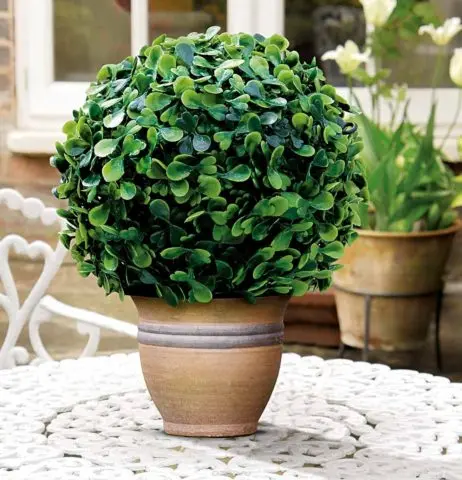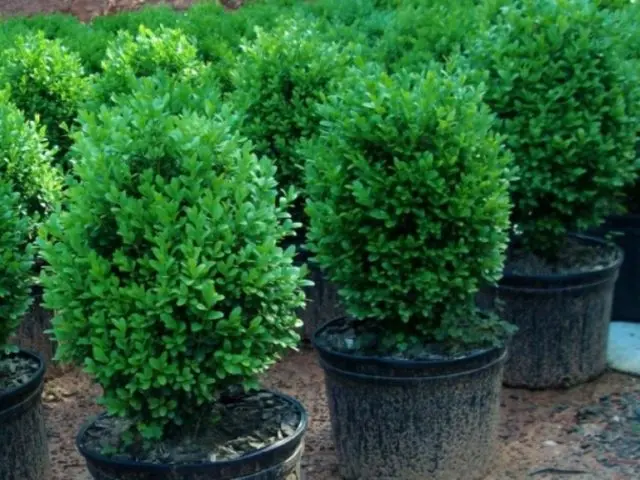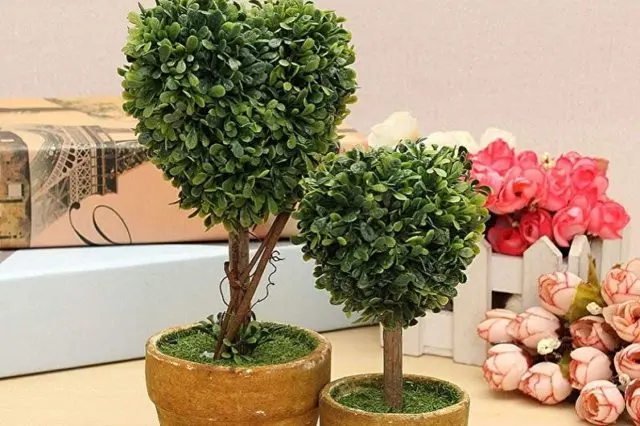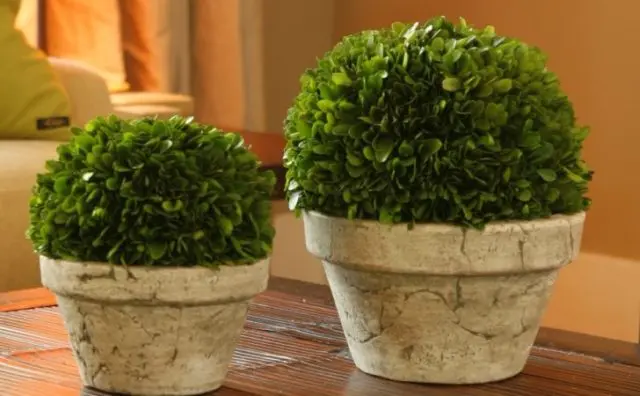Contents
Boxwood at home in a pot is ideal for fans of evergreens. A beautiful ornamental shrub is suitable not only for open ground, but also for tub cultivation, and in many ways, caring for home boxwood becomes easier.

Is it possible to keep boxwood in an apartment
Boxwood is an unpretentious evergreen shrub that adapts well to being kept indoors in a pot. As a rule, the height of such a houseplant does not exceed 60-100 cm, it is rarely necessary to transplant a shrub, since it grows very slowly. The photo of homemade boxwood shows that the shrub looks very attractive in the interior – the dark green crown lends itself well to formation, and a plant in a pot can decorate any room.
Boxwood in a pot has some features, for example, it does not bloom in home-grown conditions. However, even in the absence of flowering, boxwood at home in a pot will grow very beautifully. In addition, it purifies the air and eliminates the harmful bacteria present in it, thereby improving the home atmosphere.
What types of boxwood are suitable for home
For growing in a pot, it is recommended to buy varieties of shrubs designed specifically for indoor breeding. As a rule, they are characterized by a low maximum growth, high crown density and resistance to heavy pruning. There are several species that grow well in small tubs indoors.
Small-leaved boxwood (Buxus microphylla)
Shrub with a small but very dense crown, consisting of leaves of 2-2,5 cm each. The plant grows slowly, keeps its decorative shape well and rarely requires shaping haircuts.

Balearic boxwood (Buxusbalearica)
Shrub with large and patterned leaves of bright green color. Known for its very ceremonial decorative appearance, it grows quite quickly, but this allows lovers of evergreens to experiment more often with the silhouette of a shrub.

Caucasian boxwood (Buxuscolchica)
A slow growing shrub with a lifespan of up to 500 years or more. The leaves of the shrub are rounded-oblong, ovate, wrapped at the edges. Caucasian boxwood is very thermophilic, and therefore it is much better suited for growing in a pot than for planting in open ground.

Boxwood Compacta (Buxusmicrophylla Compacta)
Dwarf plant about 30 cm tall, with very small leaves only up to 1 cm each and a dense crown. The mini shrub grows very slowly, and takes up little space, so it is well suited for home interiors.

As for the common evergreen boxwood, or Buxussempervirens, it can also be planted in pots – the species adapts well to indoor cultivation. But caring for ordinary boxwood will be more difficult than for dwarf and hybrid species, the plant is sensitive to growing conditions and, at the slightest mistake, sheds leaves and loses its decorative effect.
Features of growing boxwood in a pot
A potted shrub can become a real decoration of the home interior, it looks good both in groups and alone, becomes a bright accent in the room, refreshes and enlivens the room. But in order for the green shrub to be truly decorative and elegant, it is necessary to meet all the requirements for growing in a pot and follow the rules for home care for indoor boxwood.
- An evergreen indoor shrub requires good, stable lighting. Exposing it to direct sunlight is not recommended, but boxwood and a thick shadow will not suit you either. It is best to place it near the southern, eastern or western windows in the area of diffused daylight. Natural light for a shrub in a pot is strictly required – the bush does not perceive artificial lighting, and it cannot replace sunlight.
- Boxwood needs fresh air, so you will have to ventilate the room as often as possible. This has a beneficial effect on the growth of the shrub; in conditions of good oxygen access, it becomes less capricious and sensitive. In summer, boxwood is often put out in pots on the street – in the courtyard of a private house, on a balcony, loggia or terrace, while providing it with a little shading.
- When caring for boxwood in a pot, it must be remembered that it needs high humidity, excessive dryness harms it. Providing the right conditions is quite simple – you need to regularly spray the shrub. Paying attention to spraying is required not only in dry summers, but also in the autumn-winter period, due to central heating, air humidity in apartments often drops dramatically.
As for the temperature, boxwood in a pot feels best in conditions of 23-25 ° C. The shrub does not tolerate heat well, so in the summer you need to ventilate the room in which the pot is located more often and additionally moisten the air. In spring and autumn, a strong drop in temperature up to 12 ° C is permissible. As for the winter time, + 5-10 ° С will become the ideal temperature regime, and if it is impossible to create such conditions – 12-16 ° С.
Caring for boxwood in a pot
Caring for boxwood in a pot is not very difficult, but requires attention. It is important to take care of the quality of the soil and the frequency of watering the plant, as well as to carry out decorative pruning in a timely manner.
What land is needed for planting boxwood in a pot
The shrub is undemanding to the ground when grown in a pot at home, both universal soil and mixtures for decorative deciduous crops are suitable for it. The main condition when choosing soil for boxwood at home is the looseness and breathability of the soil. With self-preparation of the substrate, you can mix turfy soil, sand and leafy soil in proportions of 4: 1: 2.

Boxwood grows very well in nutrient soil in a pot, but many houseplant lovers deliberately deplete the soil for shrubs. The fact is that in poor soil the plant produces shorter shoots, and its crown thickens, for decorative purposes this is only beneficial.
Watering and fertilizing homemade boxwood
An evergreen shrub in a pot has a negative attitude to both excessive moisture and a lack of moisture. Therefore, when watering, it is important to maintain a balance – the substrate should always remain slightly moist, but not swampy. It is recommended to water the shrub so that only the upper part of the soil has time to dry during the breaks; in winter, the intervals between waterings are increased.
Water for a shrub in a pot must be defended before watering, and it is even better to keep the container in a lit place so that the water is slightly lukewarm. You can also spray the shrub with cold water, but it is also recommended to stand the liquid for 1-2 days beforehand.
Both in open ground and in a pot, the plant needs regular top dressing. Usually, for young plants, fertilizers are applied once every 2 weeks, and for adults – once a month, and it is only necessary to supply the plant with fertilizers from March to August.
Shrub in a pot takes the usual universal mixtures well. But if you wish, you can feed it with special fertilizers for evergreen rhododendrons, the composition of such dressings is perfectly balanced.
Trimming and shaping
Pruning is one of the most important elements of caring for and growing boxwood in an apartment. It is regular trimming that allows you to give the bush the desired decorative shape and turn it into an element of home design.
- It is customary to trim the bushes from spring to early autumn. Young plants are best cut at the beginning of July, and if the boxwood is an adult and has already been pruned, then a haircut can be done earlier or later.
- An evergreen shrub in a pot tolerates a haircut of any intensity, even strong pruning does not harm the plant. It is necessary to carry out the formation in accordance with your wishes to the silhouette of the bush.
- To slow down the growth of a bush in a pot, its young shoots can be pinched at the tips – the beneficial effect will also be that after this procedure the crown of the plant will become thicker.
Plant transplantation
As a rule, boxwood in an apartment grows very slowly, but sometimes it still has to be transplanted into another container.
- It is recommended to transplant only if necessary, after the root system of the plant completely entangles the substrate in the existing pot. On average, it takes about 3 years, respectively, and it is necessary to replant the shrub with just such a frequency. The exception is dwarf boxwood bonsai, it is better not to transplant them at all, so as not to harm the plants.
- It is necessary to carry out a transplant from pot to pot in spring or summer – during the period when the plant is actively growing. Shrubs should not be replanted in autumn, and even more so in winter, at this time the box is in a “sleeping” state and will not take root well in a new place.
- In order to avoid damage to the root system of the plant, it must be transplanted along with the old earthen clod. You can only remove the top layer of the old soil, but you do not need to touch the ground around the roots.
The new pot should be slightly larger than the previous one – a maximum of 2-3 cm in diameter. It must be remembered that an ornamental bush grows slowly, and too spacious a container and a large amount of undeveloped soil harm the plant.

Protection against diseases and pests
Houseplant boxwood is much less affected by diseases and pests than shrubs living in the open field. This is natural, since the home microclimate, by definition, reduces the likelihood of infection by fungus or insects.
However, even in the house, the plant can suffer from ailments and pests.
- Boxwood diseases occur mainly due to improper care – waterlogging of the soil, especially in winter, drying out of the soil, insufficient spraying.
- Against the background of all of the above, root rot, wilting of leaves and weakening of shoots can develop.
- Due to serious care errors, boxwood can even completely shed foliage, and it is likely that it will not be possible to restore it.
To protect the shrub from ailments, recommendations for growing a plant in a pot must be fully implemented. It is necessary to observe the frequency of watering, do not forget to humidify the air in the room, and avoid excessive drops or rises in temperature. Do not neglect the periodic top dressing of boxwood in a pot, they strengthen its resistance to ailments.
Of the pests for indoor boxwood, scale insects and spider mites are the most dangerous. To prevent infection of the shrub, it is necessary to carry out regular spraying and from time to time inspect its leaves for harmful insects. With an average infection of boxwood in a pot with pests, it is enough to wash the leaves of the shrub with an ordinary soapy solution; in case of serious damage by pests, insecticidal garden products can be used.
Wintering boxwood in a pot
Evergreen boxwood belongs to heat-loving plants, so it tolerates wintering at room conditions much better and easier than in open ground. However, there are some nuances here – the temperature of boxwood in winter is still required to be lowered. Rooms with a temperature not higher than 5-10 ° C are considered ideal for wintering; if necessary, a shrub in a pot can be left for the winter at a temperature of 12-16 ° C, but not higher.
It is best to remove the pot with the plant on a glazed balcony or loggia for the winter period. Thus, the plant will receive the necessary low temperatures, but remain protected from wind and snow. Watering boxwood in winter should be reduced by about 2 times, the plant needs less water, and the soil dries out more slowly at low temperatures. At the same time, natural lighting should remain plentiful enough; if possible, boxwood is recommended to be placed on a balcony with windows to the south, west or east side of the world.
Reproduction of boxwood in room conditions
Even in a single copy, boxwood for the home looks very attractive. But even more impressive look a few shrubs placed around the apartment. It is not necessary to buy expensive seedlings to increase the boxwood population; the plant can be propagated independently from an existing bush.

It is best to use the cutting method. For this you need:
- in spring or early summer, cut several cuttings up to 7 cm in length from an adult plant, it is better to choose shoots that have already begun to wood at the base;
- remove the lower leaves from the cuttings;
- throughout the day, hold the shoots in water with a growth stimulator, and then bury them in a substrate from the earth mixed with sand and cover with plastic wrap.
With a high level of humidity and regular ventilation, the cuttings will give roots in just a month. After that, they can be transplanted into larger containers and gradually grow to young shrubs.
If necessary, the seed propagation method can also be used for indoor boxwood, but in practice it is used very rarely. Caring for boxwood from seeds is much more difficult, besides, seedlings grow slowly and do not enter a state of full decorativeness soon.
Conclusion
Boxwood at home in a pot can be grown without much difficulty if there is sufficient natural light and a closed balcony where the plant can winter. You need to take care of the plant carefully, but if you follow the basic rules, indoor shrubs will delight you with graceful shapes and bright green color.









